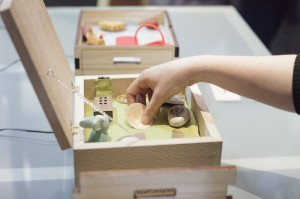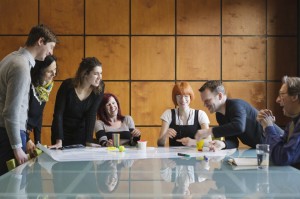These conversations took place in response to an invitation to take part in the Kallisions Artist Development programme with Kaleider in Exeter. As a total technology and digital theatre novice (and long-time cynic), I wanted to learn more about this world that forms a large part of many writers’ work, so set up a few conversations to try and find out more.
Victoria is a Producer at iShed, where she designs and delivers programmes such as Media Sandbox, and artistsʼ residency opportunities. Victoria has a background in visual art and in her spare time, co-produces projects as part of the Collect, a loose affiliation of creative producers working out the role and nature of collaboration through the act of collaboration itself. Before joining iShed, Victoria produced projects at Ffotogallery, the national development agency for photography in Wales, and co-curated independent programmes such as the Portable Cinema Project, (a part of The Arcades Project by artist Jennie Savage). (Biog courtesy of PM Studio)

Photo PM Studio
So what’s the relationship between Watershed, Pervasive Media Studio…what’s the set-up?
It is confusing! We’re working on that! The studio was initially set up as a collaboration between Watershed and Hewlett Packard with support from the South West regional development agency. The two universities (UWE and University of Bristol) have also been involved in the conversation from the outset, but only came on board as official partners a few years in.
The Studio itself grew out of the momentum of Mobile Bristol, which ran from 2002 to 2005. Very basically, Hewlett-Packard Labs in Bristol were developing lots of interesting pervasive technology platforms, and were interested in working with people in the city to learn what its application might be. So the Mobile Bristol collaboration enabled artists access and space to make location based experiences that were impossible at that time – this was well before we all had a smartphone in our pockets.
The artists also pushed the tech, broke it, asked to alter it, which had massive benefits for the developers. After that project, there was a hunger from the community to continue this kind of work and the relationships that had developed. So the studio grew out of that momentum. It was important that the Studio was a neutral space in the city – so not in a university, not in a corporate research lab – a neutral space where different people could come together, a hub in the in city – so Watershed is the perfect location.
The Studio was always managed by Watershed – in particular Clare Reddington, who is the Director of the Studio. It’s also now evolved to be a collaboration between the two universities (UWE and University of Bristol) and Watershed. The Studio is now like…a massive project, there’s loads of programmes, projects and other things running here.
And how did you become a producer at Watershed?
I don’t make work, I help other people make the work they want to make. That’s not to say my role isn’t creative, but it’s different to making work, being inside the making of the work. I would sit in a different place in terms of how you or other playwrights work, for example.
I studied Contemporary Art specialising in photography, film and video, and well, I’ve always been interested in technology – my Dad was a TV repair man, so I grew up soldering things, going out with him doing aerials and helping him fix stuff, so I grew up with it, it was part of life. But I never really knew what I wanted to do as such. My parents advised me to follow things I enjoyed doing, so that’s how I ended up working in the arts. When I finished my degree I did a lot of things over three years in a freelance capacity – you know what it’s like when you leave college, you try a bit of everything.
Were you making work back then?
I actually got into helping other people make work fairly early on. One of the things that you do quite often to earn money as a young artist is workshops, sharing skills with people: that was something I really enjoyed, working with other people to make stuff happen – this led to a position at ffotogallery in Cardiff, where I worked in the learning and participation part of the organisation, so it extended into this idea of working with loads of different people to help them make stuff: schools, colleges, life-long learning, asylum seekers, gypsies…basically everyone. These were all lens-based media projects – so basically a wide range of creative projects that involved capturing image through some form of lens and exploring the creative application of this.
Were there projects that really captured you: maybe progressive ideas that pulled you in?
One of the things ffotogallery were interested in exploring, was using technology to expand the potential of photography and lens-based media. Obviously this was 2003/4, so digital photography was becoming a thing, it was sort of a switch-over period from analogue. So there was that, but also Internet technology and a question of what we could do with online platforms. They weren’t so accessible then – but we worked with technologists to explore ideas, which was really exciting for me.
Working with communities, on participatory work…do you think it allows space for more experimentation, perhaps creating a less limited working environment?
One of the projects we did that looks so simple now, but was something schools just weren’t doing then, was the Fforest Farm Virtual Nature Reserve…it was sponsored by a healthcare firm with an interest in supporting environmental projects. We worked with conservationists and rangers in the real Fforest Farm Nature Reserve in Cardiff, and brought kids on site to research what happened there, what the issues were, and used photography as a means of documenting it.
But we also did drawings, flash animations, and eventually created a virtual nature reserve – an online space where they invented their own version of it: like a drawn landscape that you could explore. They built their own webpages for it, scanned in things, used photoshop – they did so much! It was one of those projects that just grew and grew. The kids had something they could show their families – and I loved it because it was fun, but also introduced the kids to serious things happening on their doorsteps.
I’m interested in projects that have something really tangible at the heart of them, where these processes of digital creation have a clear focus – like here, with the ability to imagine and create an alternative ecology or biosphere or something…
Yes we had two schools involved in this project, and it’s interesting thinking about what the longevity of these projects actually is. I think it’s still online somewhere. Part of it used ShockWave Player which doesn’t really exist anymore.
Is that a sound programme?
It’s used to support interactive animated elements in web pages very often. Or was! But things become obsolete, broken…they don’t work. So I feel like it should have maybe been up for a period of time and then taken down, because unless you can continuously go back and update it, it sits there just broken, decaying. I didn’t consider that at all at the time, the lifespans of technology. Only now can we see what happened.
I hadn’t considered that before. With a script, on paper, it’s not like much changes over time – we can still read it, decipher it, use it four hundred years later…but the context for technology changes so rapidly and the lesser objects get left behind to die…it’s sort of sad!
Yes! ‘I’m so old, nobody supports me anymore…’!
But the end-point – it happens, it’s up there, it stops and that’s it. I suppose there are lots of questions about legacy, user interface, evolution…
And we didn’t think about any of that at the time. We just went – oh great, we’ll have a thing and it’ll live on the internet.
You mentioned earlier about helping others make work. Part of the reason you’re good at your job is presumably a huge experience of different artists’ processes. Do you feel like you have significant impact on how people work?
I think so. How much depends on the person, what the project is, how much they already know. If people are starting from scratch, they walk in here [to Pervasive Media Studio] and it’s a bit like a sweet shop.
You’re a conduit for connections too, which is what this place is great for. It’s a hub with so many interesting people coming through, and if I don’t know where to get something from – support, programmes – I can find somebody who does.
Can you give me an example of the range of skills in Pervasive Media Studio?
Oh my goodness there’s so much stuff! There’s robotocists – artists working with robots and people working in the robot lab at the University of Bristol who hotdesk here; Space scientists; every kind of artist; designers; academics from games to visual cultures; quantum physicists; technologists of various descriptions, people who work with communication technologies, server technologies –
What’s that?
That’s kind of…well you know that the internet is a series of servers? It’s working with those.
Like the infrastructure of the internet?
Yes, kind of. A lot of technologies interweave though – communications technology for example could be a phone-based system, which links to server technology… other people here are creating their own technology platforms like AppFurnace and Nth Screen, or working with things like Arduino and Raspberry Pi boards, Raspberry Pi’s are really cheap circuit boards which were developed to get kids programming in schools.
So you have this circuit board and then…
You programme it to do something you want it to do. For example, we’re supporting a project here called Music Memory Box by Chloe Meineck. During a residency last year Chloe worked with people suffering from dementia to create bespoke music boxes. The people she worked with would make or choose special objects that they wanted to keep inside the box. Chloe then attached a unique code to each object.
When an object was then placed in the centre of the box, a hidden reader attached to a Raspberry Pi board would communicate the unique object code to the Raspberry Pi, which would in turn tell the box to play a piece of music related to that object. Does that make sense? Music and objects are a great way of triggering memories and conversation for people with dementia, which is something Chloe was really interested in.
And you could do the same thing with stories, texts, spoken memories I guess…
Yes absolutely.
I’m interested in that simple application of technology I think – one really clean sharp function in a particular context that results in something much deeper and more layered.
Have you seen Stand and Stare’s Theatre Jukebox?
No but I keep hearing about it and know that I should!
Basically it’s a wooden structure that you sit at, and in front of you are a series of cards with images on them. There’s a projection space on the table in front of you prompting you to pick a card. Each card you pick tells a story through projection and sound. Similar to Chloe’s box, the cards have electronic tags in them – RFID tags, which is the same technology that you find in Oyster cards –
What does that stand for?
Radio Frequency Identification. Basically each tag has its own unique code which is a series of numbers, and then hidden beneath the table is a reader: so each time you put a card down – you’re kind of directed to put it into a certain place – the reader identifies the code, reads it and sends the information to a computer that says ‘oh okay, I’ll play this particular piece of media then’ which is around two minutes long and tells a story.
Where from?
Well they curate stories for the Jukebox. Each curation usually consists of six cards, six miniature stories. You can listen to one as a whole experience, but then you might listen to another, and it would enrich it. Then you might listen to more and so on… as you listen you start to make connections between the stories, so each set of cards is a non-linear story, each contributing to a bigger narrative arc. They’ve created a number of different Jukeboxes, working with different partners, their first used their own family archive, they went on to work with the Mass Observation Archive, they’ve done many more, including one more recently that involved stories related to travel tickets. Stories can be told through sound, image, video, animation – they’re really inventive with this –
Ah so that screen can do other things…
Yes so you sit down, choose a card, put it down and then all sorts of things might happen around it. It is technology, but the person sitting there doesn’t see any of those workings – they’re literally just moving cards around and the technology is hidden. I think it’s really important in projects like this that the invitation is clear – that you know as an audience member what you’re meant to do, that there aren’t complicated rules.
I have to admit, I felt a bit stupid with the lamppost thing…Hello Lamppost in Bristol (which later won an award). I went on the website too, and read the instructions, but still wasn’t sure how I was meant to find things, or if I was meant to walk around and they’d just happen – and then the whole thing about finding codes on things, to me it felt impossible, I just thought ‘my God there must be millions of objects with codes on in Bristol, I could be walking around all day and not find anything!’
Part of me rejected it because of what appeared to be a difficulty to me – maybe I’m too impatient – but I wanted a map, something that showed me a trail I could follow to find these things maybe. I ended up not doing it because I thought ‘well I don’t want to spend three hours wandering around Bristol with nothing happening’. It felt like there were too many steps, and the excitement of that risk of stumbling across something, being a detective, should excite me – but I felt really turned off by the experience I’d decided I was going to have in my head, triggered by the invitation that was issued.
So I guess not every project is right for everyone – but I think your experience perhaps highlights why we ask people to test, really rigorously, test again and again. Often people will react in completely unexpected ways.
Because the audience have more agency, the rules aren’t set – unlike in a theatre, where we all know –
Exactly. And with Theatre Jukebox they went through loads of stuff, people texting to a number and so on…and at the halfway point they just said ‘right, let’s make this as simple as possible and strip it right back.’ It doesn’t need to be all-singing all-dancing technology…technology just needs to allow the experience to unfold in a way that doesn’t get in the way. And that’s always a balance to try and manage.
Who’s exciting you at the moment? Artists and projects?
I guess in here, there’s an artist called Sarah Angliss who just started working with us this week on a project called Trace. She’s a musician and poet who often works with robots, and she’s particularly interested in creating ‘uncanny’ creatures. Sarah’s working towards creating something – hopefully a performance next May, so her research here at the Studio involves collecting discarded objects, exploring how to use motion capture to capture particular gestures from their former owners, which she will use to animate the objects, probably using animatronics. The objects will then become part of a stage performance. She’s also working with people to record interviews around the objects, which again could feed into the performance.
Is she a dancer, or…?
She’s an artist-performer-composer-robotocist.
But in terms of outcome again, it seems like a very neat idea…
Yes, her work generally speaks to an electronic music audience, which is very small, but with this, she will hopefully be able to engage a broader audience with electronic music performance.
Is that as simple as it sounds? Music created electronically?
Yes, she’ll create live music on stage using samples and other things, and use her robots to draw people into the performance. She has other robots that she’s performed with for a number of years like Hugo and Wolfgang, you should check them out.
How do I find out more about the artists here?
There’s a Watershed weekly digest and Pervasive Media Studio has a monthly email too. You can sign up via the website on each.
Can you give me one thing you think I should watch online, that might fit in with all of this?
Oh God! One thing!? That’s really hard. Can I think about it and send something to you?
I’ll chase you up!
Victoria indeed followed up with these suggestions:
Ok, so I’d suggest looking at the techniques section of the Pervasive Media Cookbook, it might help in terms of designing your own projects.
I also rather enjoyed reading this…
Thank you!




